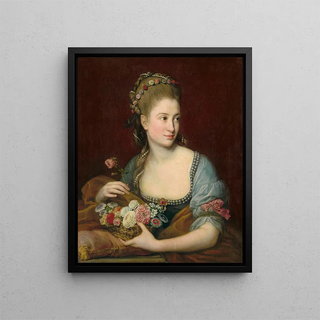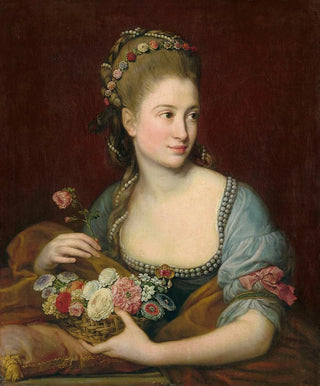Art print | Portrait of a lady in Flore - Pompeo Batoni


View from behind

Frame (optional)
Portrait of a Lady in Flora - Pompeo Batoni – Captivating Introduction
The "Portrait of a Lady in Flora" by Pompeo Batoni is a work that transcends the simple frame of painting to become a true ode to the beauty and elegance of the 18th century. This painting, emblematic of the rococo style, captures the essence of an era where fashion and art intertwined to celebrate femininity. The delicacy of the lady's features, adorned with flowers and sumptuous drapery, invites the viewer to a deep contemplation, revealing layers of meaning and emotion. The art print of this work offers a unique opportunity to appreciate Batoni's virtuosity while adding a touch of refinement to any interior.
Style and uniqueness of the work
Batoni's style is characterized by an impressive mastery of light and color, which give a striking depth to his portraits. In "Portrait of a Lady in Flora," the delicate nuances of the petals and the play of light on the protagonist's face highlight her graceful appearance. The composition is carefully balanced, with particular attention paid to details, from the embroidery of her dress to the floral ornaments surrounding her. Every element of the canvas seems to tell a story, evoking both the ephemeral nature of beauty and the richness of human emotions. This painting does not merely depict a female figure; it embodies a poetic vision of life, where nature and art come together in perfect harmony.
The artist and his influence
Pompeo Batoni, an Italian painter of the 18th century, established himself as an essential figure in European portraiture. His career, marked by prestigious commissions and international recognition, testifies to his exceptional talent. Batoni skillfully combined influences from the Bologna school and baroque, while developing a personal style that is uniquely his own. His works, often imbued with romanticism and delicacy, have inspired many contemporary and later artists. By incorporating elements of classical culture into his portraits, he contributed to shaping the image of female beauty of his time, a legacy that continues to influence artists today.

Matte finish

View from behind

Frame (optional)
Portrait of a Lady in Flora - Pompeo Batoni – Captivating Introduction
The "Portrait of a Lady in Flora" by Pompeo Batoni is a work that transcends the simple frame of painting to become a true ode to the beauty and elegance of the 18th century. This painting, emblematic of the rococo style, captures the essence of an era where fashion and art intertwined to celebrate femininity. The delicacy of the lady's features, adorned with flowers and sumptuous drapery, invites the viewer to a deep contemplation, revealing layers of meaning and emotion. The art print of this work offers a unique opportunity to appreciate Batoni's virtuosity while adding a touch of refinement to any interior.
Style and uniqueness of the work
Batoni's style is characterized by an impressive mastery of light and color, which give a striking depth to his portraits. In "Portrait of a Lady in Flora," the delicate nuances of the petals and the play of light on the protagonist's face highlight her graceful appearance. The composition is carefully balanced, with particular attention paid to details, from the embroidery of her dress to the floral ornaments surrounding her. Every element of the canvas seems to tell a story, evoking both the ephemeral nature of beauty and the richness of human emotions. This painting does not merely depict a female figure; it embodies a poetic vision of life, where nature and art come together in perfect harmony.
The artist and his influence
Pompeo Batoni, an Italian painter of the 18th century, established himself as an essential figure in European portraiture. His career, marked by prestigious commissions and international recognition, testifies to his exceptional talent. Batoni skillfully combined influences from the Bologna school and baroque, while developing a personal style that is uniquely his own. His works, often imbued with romanticism and delicacy, have inspired many contemporary and later artists. By incorporating elements of classical culture into his portraits, he contributed to shaping the image of female beauty of his time, a legacy that continues to influence artists today.






